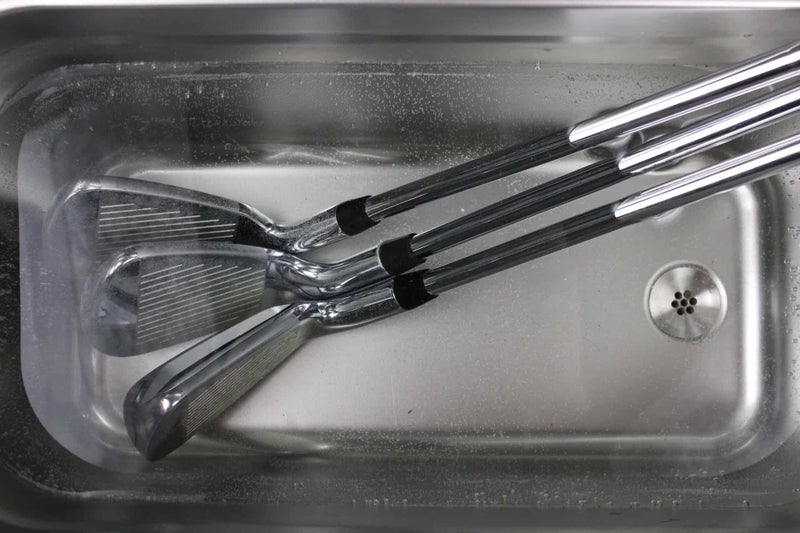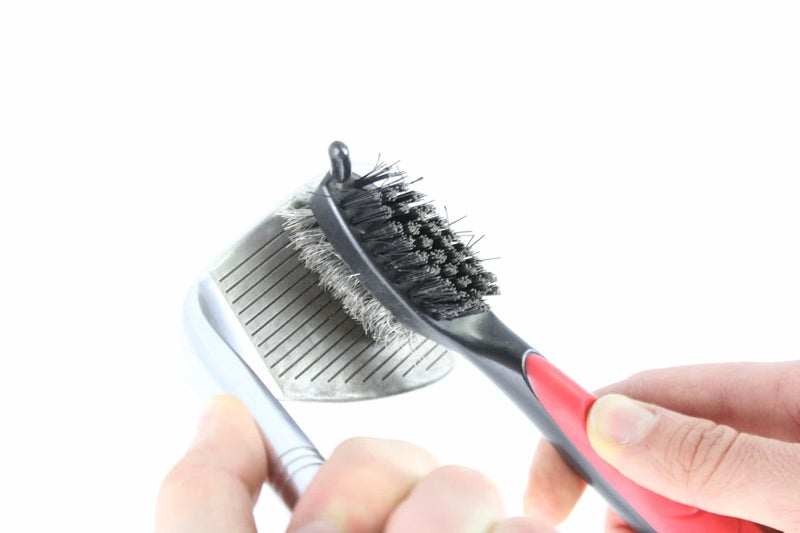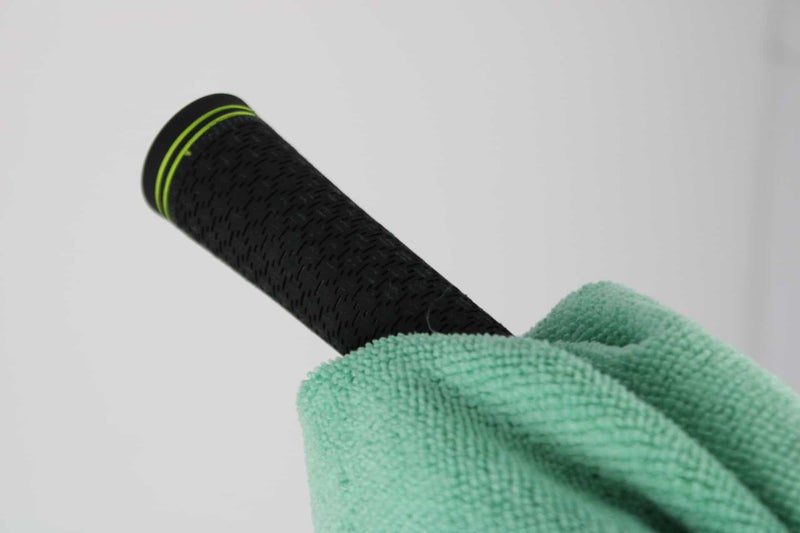-
{{link.label}}{{link.label}}
How to Wash Your Golf Clubs
On this page
Cleaning your golf clubs is an essential part of every golfer's routine. The most consistent golfers will clean their clubs after every single round, but for the rest of us who don’t have this kind of time on our hands, getting dirt off your clubs can become a challenge.
No matter if we’re talking about the clubs you’ve been playing for the past two decades or a set of refurbished golf clubs you purchased online, our tips will help you get them back to their glory days of shining beauty!
5 Simple Steps to Wash Golf Clubs:
- Mix dish soap and warm water in a bucket
- Use a soft-bristled brush to clean your golf clubs
- Get deep into the grooves with a groove-cleaning brush
- Wipe any dirt excess off the shafts with a damp cloth
- Clean your grips with a damp cloth and brush
1. Start with dish soap and warm water

The first thing you’ll want to do when cleaning your golf clubs at home will be to make a bucket where you’ll be putting in warm water and dish some soap.
“Warm” temperature is unclear for you? To put it simply, avoid very hot or boiling water. This could lead to the epoxy loosening in the clubhead, which could lead to your clubhead flying off. Also, no need to put too much water in there either, just enough that your clubheads will be fully submerged when you drop them in there.
As for the soap, no need to put a ton in the bucket, we’re not cleaning dishes after all. Simply drop four or five squirts out of the bottle in there and stir the water with your hands or one of your clubs.
With your bucket and your water ready, it’s time to dip your clubs in the water, just as if you were fishing for a lost ball in the hazard. Let them rest in the water a little longer, especially if you haven’t cleaned your clubs in a long while.
2. Clean the clubheads with a soft-bristled brush

Once the dirt has been softened by the water and the soap, it’s time to get to work. If you’re in a hurry, you can simply wipe away most of the dirt with a regular golf towel, just like you would do on the course.
But since we’re looking to do a more thorough job, here’s what we recommend you do instead:
- Wipe away the excess water when you pull the club out of the water;
- Brush your irons and wedges all over the clubheads;
- Clean as much dirt out of their grooves as you can with the soft bristles;
- Lightly brush any sizeable clubheads (drivers, fairway woods, bigger hybrids)
- Dip the club in the water one more time to disperse the loose dirt in the water;
- Dry off the clubhead with an absorbent cloth.
As for a soft-bristled brush, you can turn to an older toothbrush that no one uses anymore, or you can go with the more traditional golf brushes you can find online. We strongly suggest using a different one than the one you use on the course as it might carry some dirt from your previous rounds.
Shop All Our Hybrids and Driving Irons
3. Get deep into the grooves with the right tools

Even after cleaning your clubheads with a soft-bristled brush, you might still notice some dirt lodged in the grooves, especially with your irons and your wedges. At this point, you have two options:
- Your first will be to flip your golf brush around and use the metal-bristled side of the brush to clean out any dirt excess. These metal bristles are designed to get deeper into the grooves of your clubs to keep them as sharp as possible, something that is essential with wedges.
- If you do not have one of those brushes, you can turn to any metal tool that could fit into your grooves, without damaging them. You can find groove sharpening tools online, which are designed to fit into the grooves of a golf club. These will help clean out your grooves while helping their performance.
Be careful to use this last tool as an overly sharpened wedge will be deemed illegal in an official competition. In both cases, for the metal-bristled brush and the sharpening tool, don’t press too hard on the clubface when you’re using them to avoid damaging the club faces.
4. Wipe the dirt off your shafts

Now that you’ve taken care of your clubheads, it's time to turn your attention to the club shafts. We tend to focus on the dirt that builds up on the clubhead, but often forget to give the same attention to the shaft.
Wiping away any dirt off your club shaft is one of the easiest ways to clean your golf clubs and is worth the effort as it’ll help protect the condition of your shaft. Simply use a wet cloth to wipe away any dirt that might have built on your club.
The key to keeping your shafts rust-free is to dry off any water left on the club after wiping away the dirt. Preventing any accumulation of water and making sure that it doesn’t seep under your grip or inside your ferrule will keep away any risk of rust building up inside the shaft.
Related | When Should You Change Your Golf Clubs
5. Clean your grips with a cloth and a brush

The last essential when it comes to cleaning your golf clubs properly is taking proper care of your grips. We tend to forget about them often, but a little love goes a long when it comes to grips. The work you’ll be doing on them will be minimal, but it’ll be worth the extra minute of work.
To clean them, you’ll only a damp cloth, much like the one you used for the shaft. For most grips, simply giving a sturdy wiping of the grip with the cloth will be more than enough to clean it properly. Here again, don’t forget to dry it off if there is any leftover water on the grip.
Here’s another tip for you. If you have grips with small crevasses, such as cordless grips, you’ll want to get in those little areas. Your best bet will be to use a clean soft-bristled brush to get the dirt out of those little crevasses. Brush softly to avoid any unnecessary damage to the grip.
Finally, for optimal results, you’ll want to repeat this process after every single round you play. This way, you’ll avoid any dirt buildup and preserve the shine of your clubs.
To recap:
- Mix your water and the soap dish in a bucket (fill the water just high enough to fully submerge the clubheads of your irons);
- Use a soft-bristled brush to thoroughly clean out your clubheads (brush softly with your woods);
- Clear out the dirt from the grooves with a groove-cleaning brush (or a sharp object that fits within the grooves without damaging them);
- Wipe away any leftover dirt or splashes left in the shafts of your clubs;
- Clean out your club grips to maximize their stickiness when you’re holding them.
Until next time,
The Golf Avenue Team
Further reading
Golf season is coming to an end! Here's a comprehensive guide on storing golf clubs to avoid rust and minimize damage from the cold during the off-season.
In this one, we discuss the signs that might indicate that you need to change your drivers and how a damaged driver can affect your game. Check it out!



